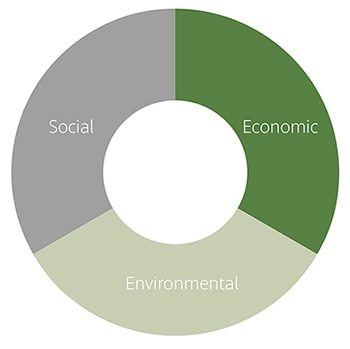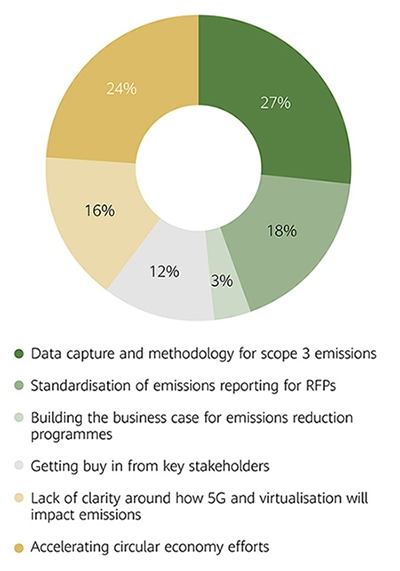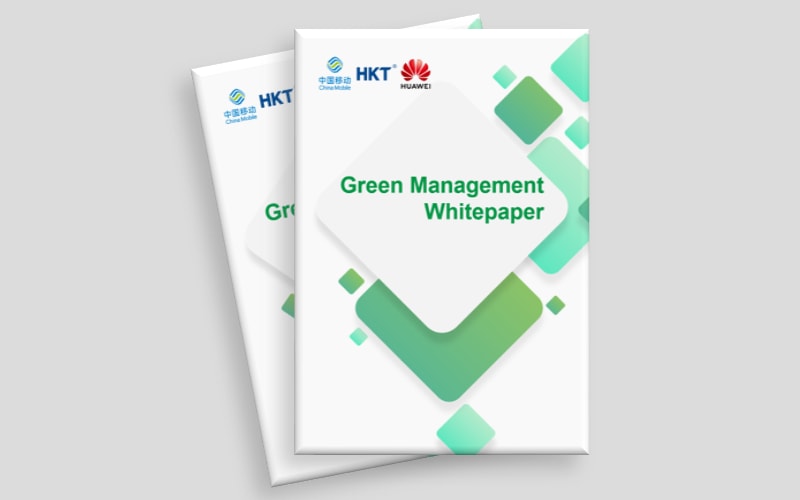Industry Trends
STL Partners: Nine Thoughts on Sustainable Telecommunications
Telecoms consultants STL Partners explain the best path for the industry to follow to achieve sustainability and net zero targets.


By STL Partners
Underpinned by digitalization and intelligence, the digital economy is a new engine of global economic growth. At the same time, the pandemic has accelerated digital transformation, including in the fight against it, and highlighted the need for a low-carbon approach to business, work, and life. STL Partners believes that telcos have a key role to play in the global transition to net-zero and has released a series of reports on sustainability in telecommunications that explore the challenges, strategies, and best practices.
STL Partners explained the best path for the industry to follow.
How do you define sustainability?
STL Partners: We’ve entered a new “Coordination Age” in which technological developments will enable governments, enterprises, and consumers to coordinate their activities more effectively than ever before. The results of better and faster coordination will be game-changing for society, as resources are distributed and used more efficiently. That will in turn lead to substantial social, economic, and health benefits worldwide.
In this context, we believe that sustainability comprises three pillars: economic, environmental, and social. The United Nations defines sustainability as “meeting the needs of the present without compromising the ability of future generations to meet their own needs.” The concept of sustainability assumes that resources are finite and should be used sparingly and strategically so they are available for future generations. In business, this is also known as the “triple bottom line”, which hypothesizes that businesses should commit to measuring social and environmental impact as well as financial performance and profit.
Businesses should spread their focus across the “three Ps”: people, profit, and planet. In essence, sustainability in business pertains to the economic, environmental, and social impact a company has on the world, including carbon emissions, employee well-being, factory conditions, and everything in between. These concepts are not new. Many companies, including operators, have pursued strong sustainability policies and practices for years. However, we have seen a recent change in attitudes and approaches to environmental sustainability from operators, especially regarding climate change. Critically, national and enterprise commitments to net-zero greenhouse gas emissions have provided an objective and measurable framework for operators to translate aspirations into urgent action.

Figure 1: Sustainability
Companies worldwide have increasingly integrated sustainability into their business strategies, formalized their sustainable practices, started to report on sustainability initiatives, and set commitments and goals such as reducing carbon emissions.
Why is sustainability necessary?
STL Partners: Until recently, most telco CEOs were reluctant to embed sustainability into company operations and make it a top business priority. Instead, it was left to internal sustainability teams to come up with sustainability initiatives and policies and persuade colleagues to implement them. Without a strong mandate, clear targets, and incentives, these initiatives risked becoming compliance box-ticking, or worse, well-intentioned distractions from the real business of running a telco. However, companies have realized that businesses will fail or be left behind if they do not embrace sustainability.
Telcos are facing increasing pressure from customers and investors to be sustainable, with customers voting with their feet and opting for sustainable companies. Millennials and Gen Z are undeniably leading the way in sustainability awareness, but customers of all age groups are considering the sustainability of the companies they do business with. A 2020 IBM study showed that 57% of customers are willing to change their purchasing habits to help reduce negative environmental impacts, and 77% of customers say it’s important to them that brands are sustainable and environmentally responsible. Nowadays investors will look at environmental, social, and governance (ESG) metrics to analyze a company’s sustainability practices, for example, gender equality on boards, climate action, engagement with communities on sustainability issues, and employee relations. According to a McKinsey report, companies with high ESG ratings have a lower cost of debt and equity, and sustainability initiatives can improve financial performance. As well as being good for business, engaging with sustainability is also good for reputation, employee engagement, and attracting and retaining talent.
STL Partners also believes that a key reason for operators to accelerate transition to net zero is that doing so will enable them to capitalize on supporting their customers’ net-zero transitions.
Why are telcos embracing sustainability?
STL Partners: Owing to the customer and investor pressures mentioned previously, telcos must embrace sustainability. However, it shouldn’t just be perceived as a risk to be mitigated – it’s also an opportunity for operators that position sustainability in their core strategy to increase their impact by supporting their customers’ transitions to low-carbon businesses with new services.
Realizing this vision comes with many challenges and requires more than goodwill. It requires understanding of sustainability as a key component to the "Coordination Age", and the conviction that a telecoms operator can offer its customers more than basic communications services. This conviction is crucial to committing to developing the new practices, metrics, governance, skills, investment, and business models required to succeed.
What progress have telcos made so far?
STL Partners: To meet their commitments and goals, telcos are increasingly integrating sustainability into all levels of operations. Sustainability will look different to every operator with different initiatives and practices, but the overall end goals are converging.
Some ways in which telcos are incorporating sustainability into their businesses are:
- Aligning their initiatives with the United Nation’s 17 Sustainable Development Goals.
- Implementing climate action initiatives, with a focus on reducing carbon emissions; disclosing current sustainability performance metrics; optimizing energy use through energy-efficient designs, component procurement, operations, and other practices; reducing greenhouse gas emissions across the supply chain, including e-waste management; and entering long-term agreements that underwrite additional renewable energy projects.
- Promoting diversity, inclusion, and gender equality; valuing all ages, genders, ethnicities, religions, disabilities, sexual orientations, education, and nationalities; and promoting and encouraging women in STEM and recruiting more women to board-level positions.
- Backing sustainable digital society initiatives on digital inclusion, security, child safety, personal data, and the use of AI.
What is the typical net-zero emissions journey from the telco perspective?
STL Partners: As a key component of sustainability, net zero emissions have a relationship with multiple SDGs. They should start with energy efficiency and then shift to emissions and greener energy supply. They should then expand sustainability organization-wide through incentives and reporting, and then address the supply chain.
To create major growth and advance as a telco, operators need to solve some of the world’s biggest problems. Some of these are:
- A desire for greater business efficiency and productivity.
- The distribution and availability of human resources and services such as healthcare, education, employment, and entertainment.
- Mitigating climate change and minimizing its effects.
- Reducing the amount of waste and harmful by-products polluting the environment.
- Concerns over employment due to automation and global economic changes.
These problems are starting to be addressed through sustainability initiatives set out by companies in their agendas and policies.
Telcos have unique assets and specific resources and capabilities such as access to data, technology, and their prevalence in the everyday lives of customers. They can contribute to tackling some of the world’s problems and help make the world run better.
A common problem is to help companies and people coordinate their resources near or in real-time. For example, to deliver sustainable energy means coordinating the variable demand of populations with supply. Wind turbines and solar panels cannot be relied on to produce at peak capacity in certain scenarios, like exactly half-time during a sporting event when people put the kettle on. Supply needs to be very flexibly managed in relation to demand.
This means sharing information about those resources and demands effectively, which in turn takes modern communications capabilities. Thus telcos are well-equipped to help enable sustainability.
What else should telcos be doing?
STL Partners: Incorporating the many forms of sustainability into strategy and operations can be daunting, but long-term thinking and strategic planning are critical for success with sustainability strategies. There’s still a long way to go and if telcos can demonstrate that they’re committed in their own businesses, there’s a significant upside in helping their customers become more sustainable. Ways in which telcos can do this are:
- Formally committing to ambitious net-zero targets for their own operations and the embedded carbon in their supply chain.
- Linking executive and employee incentives like bonuses to stimulate progress.
- Adopting sustainability procedures, governance, accountabilities, reporting, and support systems.
- Putting clear commercial pressure on the vendor community and other parts of their supply chain to make their operations and products green, and stop doing business with those who don’t.
- Issuing green bonds, like Telefónica did in 2019, becoming the first European telco to do so.
- Directly and indirectly supporting enterprise and public sector customers in their transition to net-zero by offering new IoT, energy, and emissions management services; product labeling; and sharing best practices.
What else should telcos be doing?How can telcos be sustainable and profitable at the same time?
STL Partners: One of the often-cited challenges is how to invest in sustainability without damaging profits. However, this is a false economy, because the cost of not being sustainable will impact enterprise value in terms of things like harm to reputation, the ability to attract and retain employees and customers, declining investor base, and the increasing price of energy.
Research shows that engaging with sustainability is good for business and financial performance. A 2019 Deutsche Bank report revealed that companies that experience positive press on environmental impact saw share prices outperform the MSCI World Index by 26% year-on-year. The report also found a link between bad press regarding environmental impact and share price performance.
The telecoms industry can play a role in supporting other industries transition to net zero, with digitalization, remote automation, and employee enablement all common examples. In 2019, GSMA launched an industry-wide climate action plan to achieve net-zero greenhouse gas emissions by 2050, in line with the United Nation’s Framework Convention on Climate Change 2015 Paris Agreement.
The telecoms industry can also make a difference to the social and environmental impact of its supply chain. This can be done through initiatives such as enforcing health and safety regulations in factories, managing risks associated with the types of labor used across the supply chain, and monitoring energy consumption.
Remote working is one example where telcos can play a key role in helping to reduce carbon emissions. During the COVID-19 pandemic, the robustness of telecoms networks has enabled hundreds of millions of employees to work remotely, making a strong case for reduced work-related travel in the future. Many business activities and practices that previously assumed in-person communication have gone online, with employees no longer needing to commute or travel by air for meetings.
What are the biggest challenges for telcos to reduce carbon emissions?

Figure 2: What are the biggest challenges around reducing carbon emissions for telcos?
STL Partners: Even where the most effective mechanisms have been adopted, it’s doubtful whether they can claim to be 100% zero-emission. With the possible exception of a handful of countries with abundant hydro, geothermal, or nuclear power, renewable energy comes from either from biomass (burning non-fossil fuels, which creates CO2 emissions, albeit more recently extracted from the atmosphere), or from non-emitters, but less predictable, renewable sources: solar and wind power.
The simple truth is that networks need a continuous power supply to work. Even where operators have purchased 100% renewable energy, their suppliers have usually had to “borrow” some electricity from another (typically fossil fuel-based) source when the sun isn’t shining or the wind isn’t blowing. This energy loan is then given back later so that the result is 100% net renewable – an elegant accounting trick that does not actually reflect the reality of what happens.
And this problem doesn’t go away if we increase renewables’ generation capacity because windless, dark days still mean energy has to come from somewhere else. Storage – in batteries, as hydrogen, or by pumping water back up into dams – can potentially alleviate this and get away from accounting trickery to make genuinely 100% renewable sources. But that’s hypothetical.
Even if and when storage is possible, there will be some embedded carbon required to build and install the generating and storage facilities. In the worst cases, hydro-electric dams can have many years of carbon payback embedded in civil works, concrete, and the lost carbon capture of submerged ecosystems.
Operators are right to prioritize optimization and energy efficiency and reduce the power they use to run their networks. However, the operators that are the furthest on their net zero emissions journey are now also tackling the elephant in the room: embedded carbon from their supply chain, which is far tougher to solve.
What other advice would you give to telcos?
STL Partners: Work with third-party specialists for skills and neutrality. We’re already seeing many operators doing this – in particular working with third parties to create carbon reporting and disclosure policies and to evaluate products with eco-design principles. As well as bringing experience and skills, these third parties can lend confidence to reported outcomes.
Collaborate with others to drive industry level change. Operators can achieve significant sustainability improvements by themselves, but they can do more by collaborating with their suppliers. And in many cases it will be whole industry-wide initiatives (led by bodies like the GSMA and JAC) that will enable the standardization and scale that’s required.
- Tags:
- Environment
- Carrier






